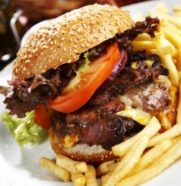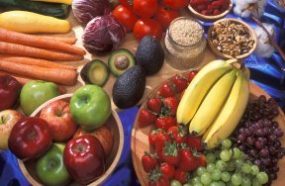Eat Out, Eat Smart
Knowing the number of calories in your restaurant meal can help you make healthier food choices.
By Emily Sohn
Eating out forces you to make some important decisions: Do you want french fries or onion rings? Ranch dressing or vinaigrette? Ice cream or cheesecake?
Depending on where you live, many of your favorite restaurants may soon add another type of choice to their menus: high-calorie or low. New York City will even require certain restaurants to put nutrition information on their menus. The city will also ban heart-damaging trans fats from restaurants and bakeries.
 |
|
How many calories are there in this cheeseburger meal? |
| iStockphoto.com |
It’s a controversial move that nutritionists, doctors’ groups, and some politicians have supported for years. Now, cities and states around the United States are considering similar regulations.
If and when menu-labeling rules show up in a restaurant near you, you may be surprised to learn that a BK Double Whopper with Cheese has 990 calories. An Arby’s Broccoli & Cheese Baked Potato has 536 calories. And a medium chocolate malt at Dairy Queen has 760 calories. Most adults and teenagers need about 2,000 calories a day, depending on body size and activity level.
Nutrition advocates hope that being able to see calorie counts will change what diners decide to eat or, better yet, what not to eat.
“This would provide people with a tool that could lead to huge decreases in calorie intake,” says Margo Wootan. She’s nutrition policy director at the Center for Science in the Public Interest (CSPI) in Washington, D.C.
Obesity epidemic
People in the United States now eat restaurant food twice as often as they did in the 1970s, Wootan says. In fact, kids and adults get about a third of their calories from eating out.
 |
|
Fried potatoes add fat to any meal. |
| Photo by Scott Bauer, Agricultural Research Service, USDA |
All that soda slurping and french fry chomping are showing up on the nation’s waistline, according to a report published last year by the U.S Food and Drug Administration. The report found that people who eat out more often devour more calories but less healthy stuff, such as fruits, vegetables, and milk, than people who usually eat at home.
A 1999 study found that women who ate out more than five times a week chowed down about 300 more calories a day than women who ate at home more often.
In the United States, two-thirds of adults and 15 percent of 6-to-19-year-olds are overweight or obese. Weighing too much makes people more likely to develop diabetes, heart disease, and other health problems (see “Packing Fat”).
One common practice of today’s restaurants—supersizing—is a real diet buster, says Barbara Rolls. She’s a nutrition scientist at Penn State University in University Park. In one of her most recent studies, people ate more and more as researchers increased portion sizes over 11 days.
“They just keep overeating,” Rolls says. “That’s pretty bad news. You can’t rely on other people to serve the right amount of food, and you can’t rely on your body to tell you when to stop.”
Restaurant meals
Restaurant meals tend to be calorie dense. This means that a bite of a restaurant meal contains more calories than a bite of a home-cooked meal does. By adding water, fruit, and vegetables to recipes, Rolls has found, people can eat just as much food but with 25 percent fewer calories. And they still feel full.
 |
|
If people added more fruits and vegetables to their meals, they could eat just as much food as before but consume fewer calories and still feel full. |
| Photo by Stephen Ausmus, Agricultural Research Service, USDA |
No one wants to eat unhealthy, fattening foods. But good intentions alone don’t necessarily lead to healthier choices. People tend to guess that unhealthy restaurant meals have half as many calories and grams of fat as they actually do, according to a 2006 study by researchers at the University of Arkansas and Villanova University. Even dietitians underestimated fast-food meals by up to 600 calories in a 1997 study by CSPI and New York University.
The only way to make sure people know what they’re eating is to supply obvious, easy-to-understand labels, nutrition advocates say. People are often surprised to learn, for example, that roast beef has fewer calories than tuna salad, or that baby back ribs can be healthier than fried chicken fingers.
Labeling can change how people eat, Rolls says. Studies show that people choose healthier options with fewer calories when given nutrition facts.
“So much marketing goes into selling foods that are not optimal for our health,” Rolls says. “We need more emphasis on marketing healthy, reduced-calorie foods presented in reasonable portions.”
Nutrition information
New York City’s new labeling rules will apply only to restaurants that already offer nutrition information on Web sites, posters, or elsewhere. For now, that includes about half of the nation’s fast-food chains, Wootan says, such as McDonald’s, Wendy’s, Burger King, and Starbucks.
 |
|
If nutrition information were available on menus, would people make more-healthful meal choices? |
| Photo by Peggy Greb, Agricultural Research Service, USDA |
New York City’s health department is also one of the leaders in targeting trans fats.
Trans fats can be found in many types of cookies, crackers, baked goods, fried foods, and margarine. As an ingredient, trans fat is useful because its molecules hold together in the same shape for a long time. Thus means that trans fat–filled foods taste the same and have the same texture, even after they’ve been sitting on the shelf for months or years.
That’s good for sales, but not for people. To make trans fats, manufacturers add hydrogen to vegetable oil, turning liquid oil into solid fat. Eating even small amounts of trans fats raises levels of a fatty substance called cholesterol in our bodies. High levels of cholesterol lead to heart disease and other health woes.
Not everyone supports the changes, including the restaurant industry. For one thing, says National Restaurant Association spokesperson Sue Hensley, it’s impossible to come up with accurate calorie counts because customers make special requests, and individual chefs vary ingredients and portion sizes.
Restaurants may also be discouraged from offering nutrition information, she adds, if they know they’ll have to redesign their menus.
Nutrition advocates suspect that the Restaurant Association is resisting the move for fear that diners will start demanding healthier options once they see the facts. Restaurants will then have to do more than just redesign their menus—they’ll have to change their recipes. Many businesses are already scrambling to replace trans fats.
 |
|
Baked goods, such as muffins, may contain trans fats. |
| Photo by Scott Bauer, Agricultural Research Service, USDA |
As communities around the country consider following New York City’s lead, you might want to educate yourself before your growling stomach takes control of your brain. Many restaurant chains already offer nutrition information online. You can also learn basic facts about food preparation. Grilled items, for example, are healthier than fried.
Plan ahead for a long, healthy, and delicious life.
Going Deeper:







